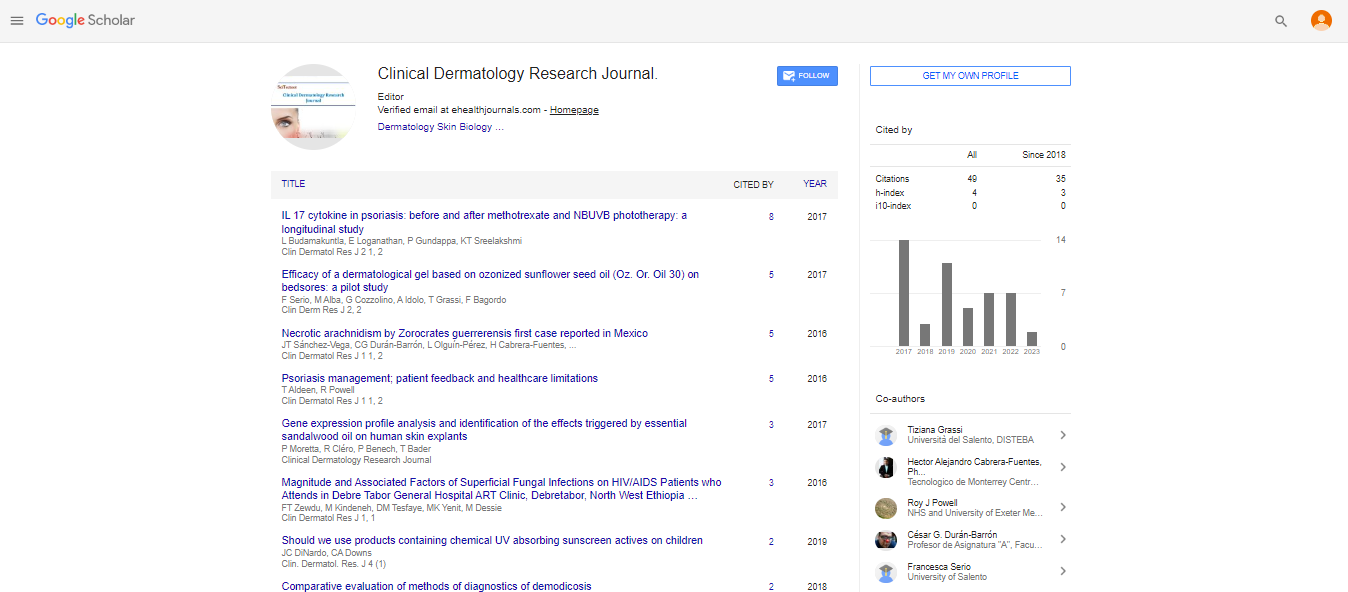Commentary, Clin Dermatol Res J Vol: 9 Issue: 1
Clinical Dermatology Diagnosis and Management of Skin Disorders
Sarah Elbuluk*
Department of Dermatology, Keck School of Medicine, University of Southern California, Los Angeles, CA, USA
- *Corresponding Author:
- Sarah Elbuluk
Department of Dermatology,
Keck School of Medicine,
University of Southern California,
Los Angeles,
CA,
USA;
E-mail: nada.elbuluk@med.usc.edu
Received date: 03 October, 2023, Manuscript No. CDRJ-23-115483;
Editor assigned date: 05 October, 2023, PreQC No. CDRJ-23-115483 (PQ);
Reviewed date: 19 October, 2023, QC No. CDRJ-23-115483;
Revised date: 03 January, 2024, Manuscript No. CDRJ-23-115483 (R);
Published date: 10 January, 2024, DOI: 10.4172/2576-1439.1000221
Citation: Elbuluk S (2024) Clinical Dermatology Diagnosis and Management of Skin Disorders. Clin Dermatol Res J 9:1.
Description
Dermatology is a specialized branch of medicine focused on the diagnosis and management of skin disorders. The skin, the body's largest organ, serves as a protective barrier and plays a crucial role in maintaining overall health. Dermatologists are medical professionals who are trained to identify and treat a wide range of skin conditions, from common issues like acne to complex diseases such as melanoma. This essay will explore the essential aspects of clinical dermatology, including the process of diagnosis and the various treatment options available for skin disorders.
Diagnosis in clinical dermatology
Patient history: Successful diagnosis in clinical dermatology begins with a comprehensive patient history. Dermatologists interview patients about their symptoms, medical history, family history, and lifestyle factors. This information helps narrow down potential diagnoses and guides further examination.
Physical examination: A thorough physical examination of the skin is a cornerstone of dermatological diagnosis. Dermatologists carefully inspect the skin's texture, color, temperature, and moisture. They assess lesions, rashes, moles, and other abnormalities to determine their characteristics and distribution.
Diagnostic tools: Dermatologists often use specialized diagnostic tools to aid in diagnosis, such as dermatoscopes for magnified examination of skin lesions. Biopsies may be performed to obtain tissue samples for laboratory analysis. Additionally, imaging techniques like ultrasound or MRI can be valuable for evaluating deeper skin structures and assessing tumors.
Differential diagnosis: Dermatologists employ a process called differential diagnosis to distinguish between various skin disorders with similar symptoms. By considering all possible diagnoses and ruling out less likely options, they can arrive at an accurate conclusion.
Common skin disorders and their management
Acne: Acne is a prevalent skin condition characterized by pimples, blackheads, and whiteheads. Treatment options range from topical medications, such as retinoids and benzoyl peroxide, to oral antibiotics and hormonal therapies. Dermatologists may also recommend lifestyle modifications and chemical peels for more severe cases.
Eczema (Atopic dermatitis): Eczema is a chronic inflammatory skin condition that causes itching and rash. Dermatologists often prescribe emollients and topical corticosteroids to manage symptoms. In severe cases, systemic immunosuppressive medications may be necessary.
Psoriasis: Psoriasis is an autoimmune disorder that leads to the rapid growth of skin cells, resulting in thick, scaly patches. Treatment options include topical corticosteroids, phototherapy (light therapy), systemic medications, and biologic therapies that target specific immune pathways.
Skin cancer: Skin cancer, including melanoma, basal cell carcinoma, and squamous cell carcinoma, requires prompt diagnosis and treatment. Dermatologists perform skin biopsies to confirm cancer, and treatment options may include surgery, radiation therapy, chemotherapy, immunotherapy, or targeted therapy, depending on the type and stage of cancer.
Rosacea: Rosacea is a chronic inflammatory condition that causes redness and visible blood vessels on the face. Management often involves topical and oral antibiotics, laser therapy, and lifestyle modifications to minimize triggers.
Dermatitis: Dermatitis encompasses various skin inflammation conditions, including contact dermatitis and seborrheic dermatitis. Treatment depends on the specific type but may include topical steroids, antifungal creams, or allergen avoidance.
Emerging trends in dermatology
Telemedicine: The advent of telemedicine has revolutionized dermatology by allowing patients to consult with dermatologists remotely. This technology has proven especially useful during the COVID-19 pandemic, ensuring continuity of care while minimizing physical contact.
AI and machine learning: Artificial Intelligence (AI) and machine learning are increasingly used in dermatology to assist in diagnosis. AI-powered dermatoscopes can analyze skin lesions and provide automated assessments, enhancing diagnostic accuracy.
Personalized medicine: Dermatology is moving towards personalized medicine, where treatments are tailored to individual patients based on their genetic and molecular profiles. This approach can optimize treatment outcomes and reduce side effects.
Clinical dermatology plays a vital role in diagnosing and managing a wide range of skin disorders, from the common to the rare and complex. Through a combination of patient history, physical examination, diagnostic tools, and differential diagnosis, dermatologists can arrive at accurate diagnoses and recommend appropriate treatments. The management of skin disorders often involves a multifaceted approach, including medications, lifestyle modifications, and advanced therapies.
As dermatology continues to evolve, emerging trends such as telemedicine, AI, and personalized medicine promise to enhance the field's capabilities and improve patient care. With ongoing research and innovation, dermatologists are better equipped than ever to address the diverse and evolving challenges of skin health, ultimately promoting the well-being of individuals across the globe.
 Spanish
Spanish  Chinese
Chinese  Russian
Russian  German
German  French
French  Japanese
Japanese  Portuguese
Portuguese  Hindi
Hindi 

